Download the PDF version of this report by clicking here.
Key Insights
- Almost all metrics took a hit in the aftermath of Terra’s collapse; volume, liquidity, and user counts were all down to various degrees.
- The scope of assets expanded to include ERC-20 assets, which will be critical to the app-chain’s continued mission of becoming the dominant multichain decentralized exchange (DEX).
- UST has been replaced by USDC and (to a lesser extent) DAI though the two ERC-20 stablecoins don’t currently compare with UST in terms of supplied liquidity.
- OSMO staking continues to increase even post-Terra as superfluid staking goes live on new DEX pools.
- An exploit of the protocol shut down the blockchain from June 8–12; attackers took $3 million in tokens, but the majority of them have expressed interest in returning exploited amounts.
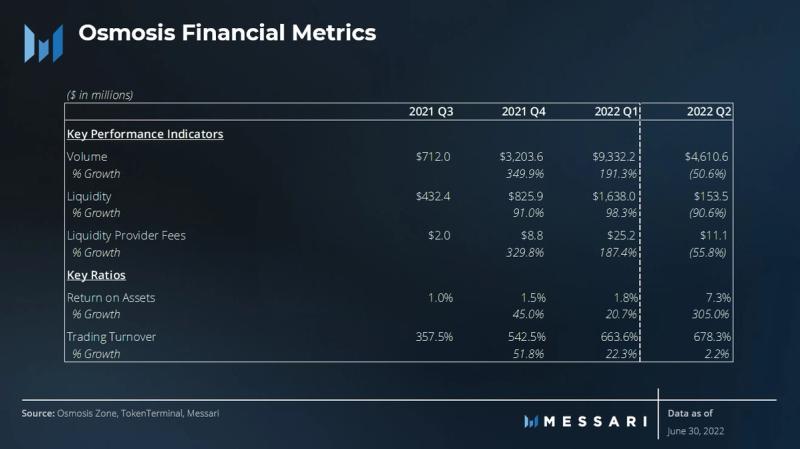
A Primer on Osmosis
Osmosis is a sovereign DEX-focused app-chain in the Cosmos ecosystem, meaning it serves simultaneously as a blockchain and an application. The application operates similarly to other AMM functioning DEXs — liquidity providers (LPs) are responsible for supplying liquidity to asset pools where traders can make trades from. It’s the same model for Uniswap or Balancer, though more similar to the latter as Osmosis places a high priority on offering asset pool customization. Tweaks to market-maker functions, swap costs, token weighting, and more, are all parameters that can be changed within the DEX.
Summary of Q2
Two events were notable in Q2. The first was the collapse of the LUNA ecosystem. Much of Osmosis was integrated with LUNA products. For example, UST was used as the de facto stablecoin for stablecoin-pegged trades. LUNA or UST-paired pools accounted for over 50% of trading volume prior to mid-May 2022.
The second was an exploit of the code taken advantage of by attackers. Impact was well-contained, a credit to the prompt response of the Osmosis Labs team. Both events, as well as their effects, are covered further below.
Performance Analysis
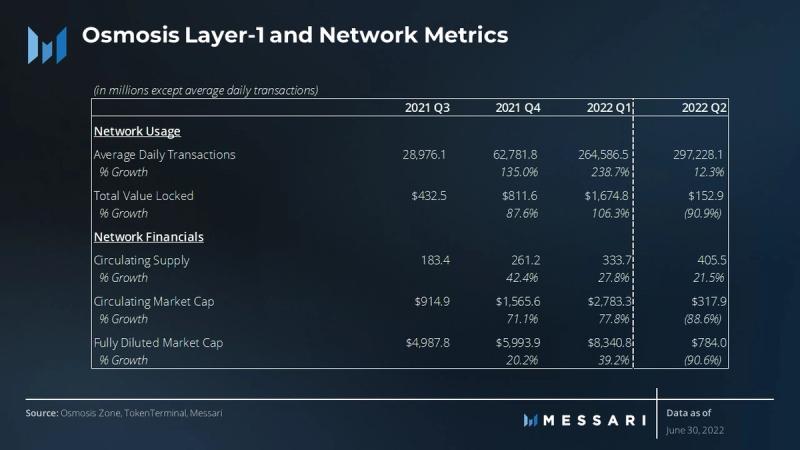
As an app-chain, Osmosis can be analyzed both as an independent Layer-1 network as well as a separate DeFi protocol.
Layer-1 Metrics
Although total value locked (TVL) can be a flawed metric, reviewing the trend over time can provide a high-level picture of performance. In this instance, Osmosis TVL metrics neatly summarizes the app-chain’s volatile Q2: it started the quarter trending upward near its peak of $1.8 billion TVL but declined 90% to levels not seen since its first few weeks of going live.
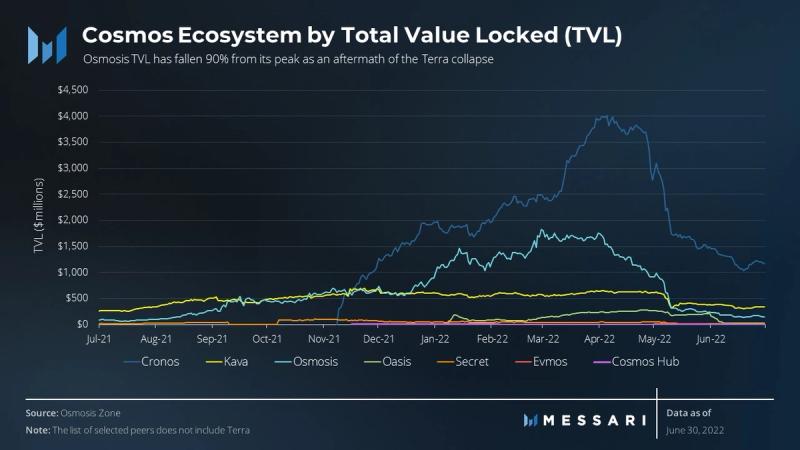
That said, Osmosis still ranks third in this metric among our selected peer Cosmos chains. It began the quarter behind Cronos and slipped behind Kava. Compared to the vast majority of peers, Osmosis grew the most in percentage terms, then fell the most as well.
One bright spot for Osmosis in the universe of app-chains is its connectivity to other Cosmos blockchains. A look at Map of Zones shows the most Inter-Blockchain Communication (IBC) volume of any app-chain, making it arguably the de facto “hub” of the Cosmos ecosystem.
Outside of Cosmos and more general, most crypto participants value the metrics of network security and decentralization when evaluating Layer-1 networks.

Over 148 million native OSMO tokens are staked on the app-chain as of June 30. Contributors increased the cumulative number of OSMO tokens staked by an average of 0.25% each day this quarter. Notably, the rate is slightly higher than the estimated 0.22% daily emissions rate of new OSMO tokens.
The driving force behind the count of tokens being staked is the variation of superfluid staking in specified OSMO pools. Most prominently, roughly 7% of staked OSMO liquidity was tied to the LUNA/OSMO and UST/OSMO pools. On May 19, a vote was submitted to remove superfluid staking from those pools, encouraging individuals prone to pulling their capital to do so.
To increase OSMO staking, 10 new superfluid pools were approved by governance vote in Q2. Some were directly intended to replace the pullback in Terra-related OSMO pools. Again on May 19, another decision was made to enable superfluid staking for USDC/OSMO, DAI/OSMO, and WETH/OSMO. The three pools at the time added up to 7.2% of pooled OSMO, balancing out the effect of removing superfluid staking from the Terra pools.
Beyond the immediate reallocation of incentive, superfluid staking was enabled for seven other pools. Among those seven, a few pools had meaningful liquidity, such as the JUNO/OSMO pool and the WBTC/OSMO pool, among others.
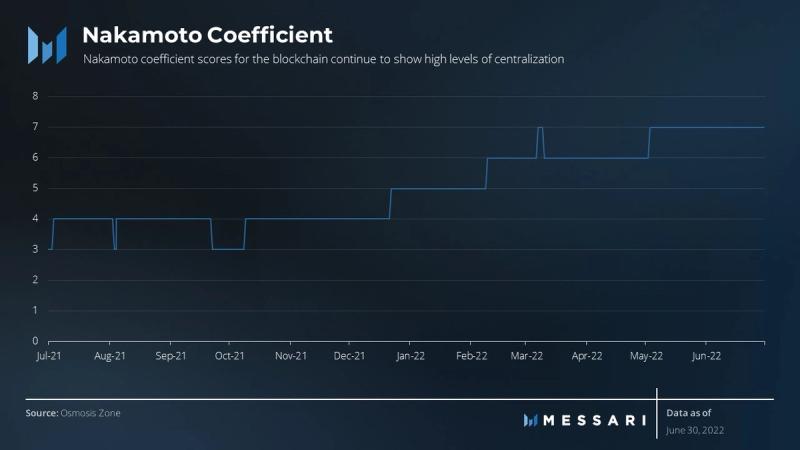
Osmosis finished Q2 with 135 validators providing security to the chain, up 14.4% from the previous quarter. That rounds out the Nakamoto Coefficient to 7, up marginally from last quarter’s value of 6. Metrics like Nakamoto Coefficient may not matter to users in the day-to-day function of the network, but for the health of the network, it’s an area where Osmosis could continue to improve.
Although day-to-day users might not care much about the Nakamoto Coefficient, Osmosis still has room to improve in the long run if it wants to offer a more decentralized product.
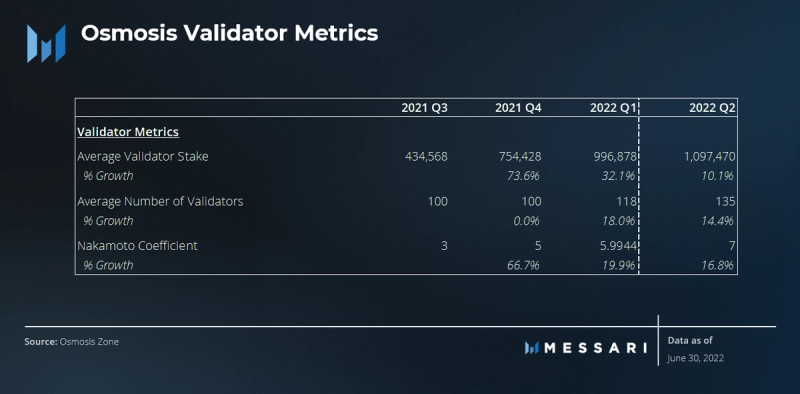
Low decentralization remains one of the weaknesses of Cosmos SDK blockchains. Though the ecosystem may attract a strong community, the need for each app-chain to bootstrap its own set of validators means less decentralization for all. It’s a different approach taken to Ethereum, (which is fairly centralized via liquid staking) but this chosen setup does lead to essentially one shared set of validators across all Cosmos chains. At the end of the day, those validators may have little loyalty to any one chain in particular.
Q2 Protocol Exploit
On June 7, a Reddit user warned of a potential exploit on Osmosis. The attack was simple: deposit liquidity into a pool and, by way of the bug, withdraw an extra 50% upon removal. Attackers began to take advantage of the exploit. Shortly thereafter, Osmosis Labs alerted validators to halt the chain to prevent all pools from being drained.

In total, a little under $5 million of exploited tokens were taken. The attackers were careful to target tokens with the highest liquidity. ATOM, OSMO, and USDC were the top three tokens, comprising 90% of the extracted capital. WETH and WBTC were also targeted, but liquidity was not deep enough at the time to cause significant losses. The remaining mix of tokens were not heavily impacted. Total amounts exploited ranged from a few hundred dollars to less than one dollar.
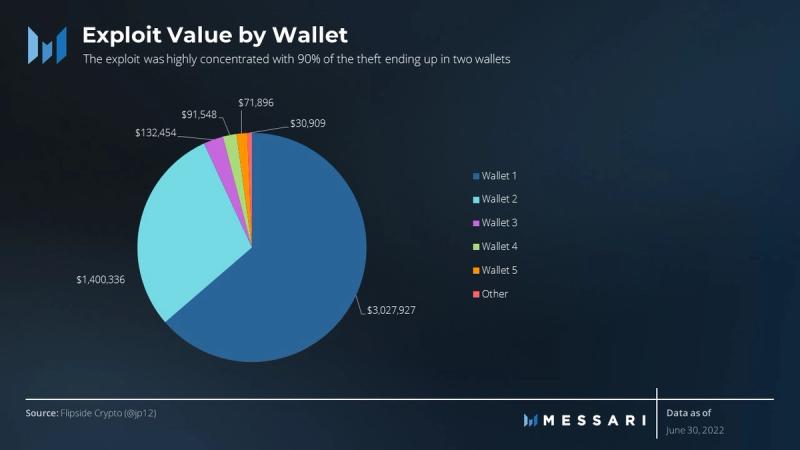
Two wallets took the large majority of tokens in the exploit, with one of them being responsible for 63.7% of the total funds stolen. Fortunately for Osmosis, almost all exploiters were working to return funds to the protocol. The Osmosis developer fund covered any remaining unrecovered funds.
Once the dust settled, the end result was relatively benign. Aside from a temporary halt in the blockchain, a safety feature of Tendermint’s BFT consensus protocol, Osmosis didn’t need to reverse any transactions or fork the underlying blockchain. Code patch releases were quick, and the app-chain continues to operate normally today.
DEX Metrics: Macro
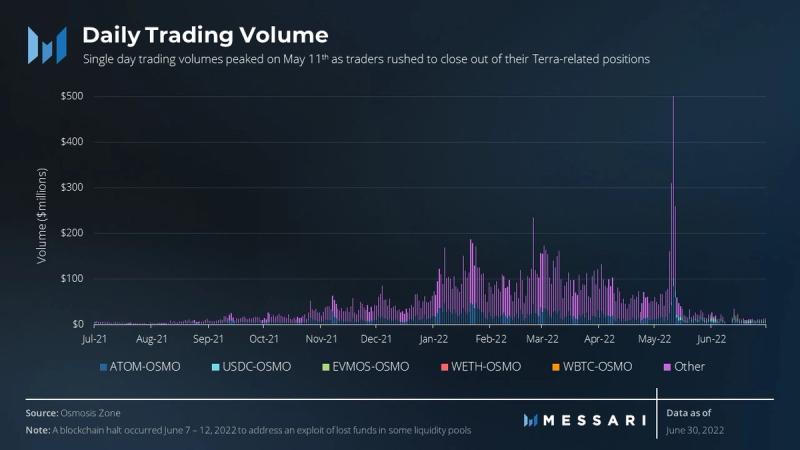
When it comes to the crypto economy, one protocol’s misfortune can be another’s fortune. In the latest quarter, Osmosis benefitted from the failure of Terra’s ecosystem. The daily peak from this quarter occurred on May 11 and was more than double the volume of the previous all-time-high. May 10 and May 12 were also higher than the previous all-time high. Together, the three days amounted to over $1 billion of activity on the DEX.
The bump in volume was temporary, however, as the rest of the days in the quarter could not sustain the elevated activity. Including the period in May, total volume in Q2 2022 summed up to $4.6 billion. In other words, the three days accounted for nearly a fourth of the entire quarter’s volume. Lackluster volume from the remaining period also meant Q2 volume dropped more than 50% from the $9.3 billion seen in Q1.

As prices go, so does liquidity. At the start of the quarter, liquidity providers (LPs) had contributed $1.6 billion of capital to the DEX’s pools. By the end of the quarter, that number wilted down to $153.5 million. The drop in liquidity was a consequence of two factors. First, LPs likely pulled back capital as market conditions worsened. But even more importantly, the drop in liquidity is a direct consequence of this past quarter’s rough market environment.
Terra ecosystem’s sudden asset price deterioration contributed heavily in particular. Whereas centralized exchanges voted to paused withdrawals to stop the bleeding, Osmosis governance voted to unbond LPs pooled with LUNA and UST to prevent those LPs from becoming exit liquidity for panic-selling Terra holders. This was quickly reflected in each pool’s liquidity. For example, the LUNA-UST pool had $55.4 million of liquidity on May 10. Within two weeks, that same pool had less than $6,000. A similar story exists for LUNA-OSMO. What was originally $113.8 million of liquidity quickly fell to around $100,000. Those two pools, alongside several others supporting LUNA and UST, rapidly became the backbone of Q2’s liquidity story.
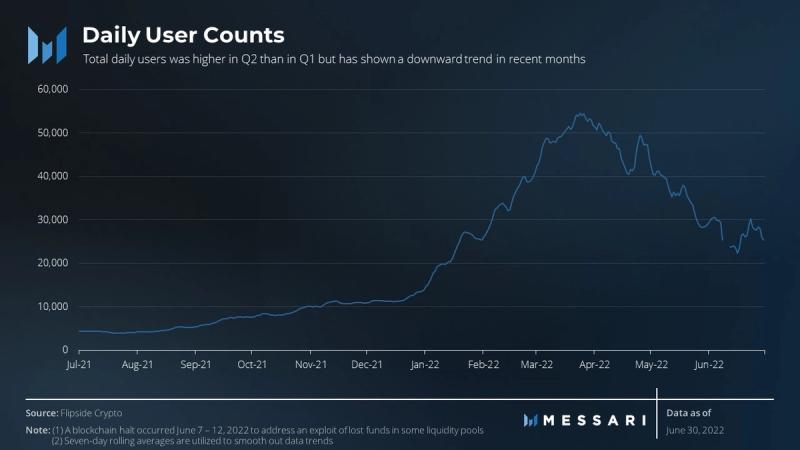
Daily user counts is the one area where Osmosis metrics have not fallen as significantly. Osmosis governance was fortunate to have spent the weeks prior to Terra’s crash voting on its canonical Ethereum bridge provider. The vote was one of many in a process that set off Osmosis as a multichain DEX capable of trading ERC-20 tokens (more info in Select Governance Updates). How Osmosis performs in subsequent quarters may depend on how it leverages its core value proposition: allowing users to trade emerging Cosmos ecosystems as well astraditional Ethereum-native applications. For Osmosis to rebuild in that direction, the first step must be to replace UST-pegged markets with those backed by alternative stablecoins.
DEX Metrics: Post-Terra Stablecoin Analysis
Why are stablecoins such an important first step? They are a huge point of emphasis for DEXs because they offer two-sided benefits to market participants. On one hand, traders prefer to trade against a stable asset. It helps with price discovery and reduces general volatility of the market when one half of the pool is a stablecoin versus another token.
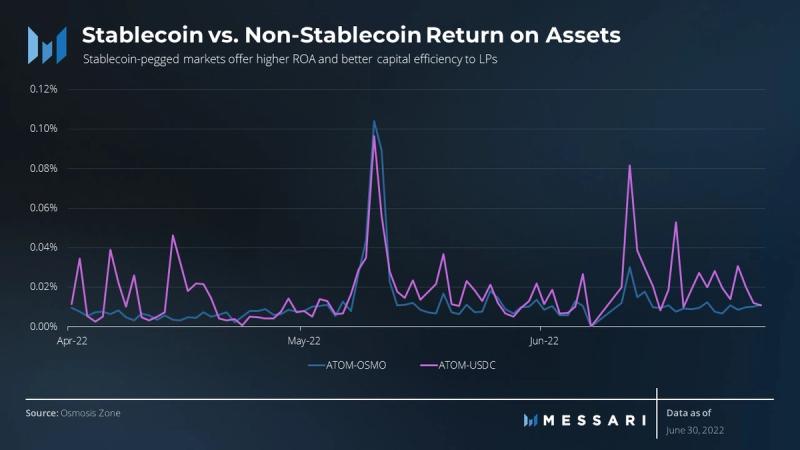
Trader preferences lead to higher return on assets (ROA) for stablecoin-pegged pools compared to pools without stablecoins. This is evidenced in the chart above comparing ROA between ATOM-OSMO and ATOM-USDC. It demonstrates how capital efficiency is better for each dollar of liquidity provided by LPs. Note this doesn’t take into account the effect of impermanent loss, just strictly the revenue earned from fees.
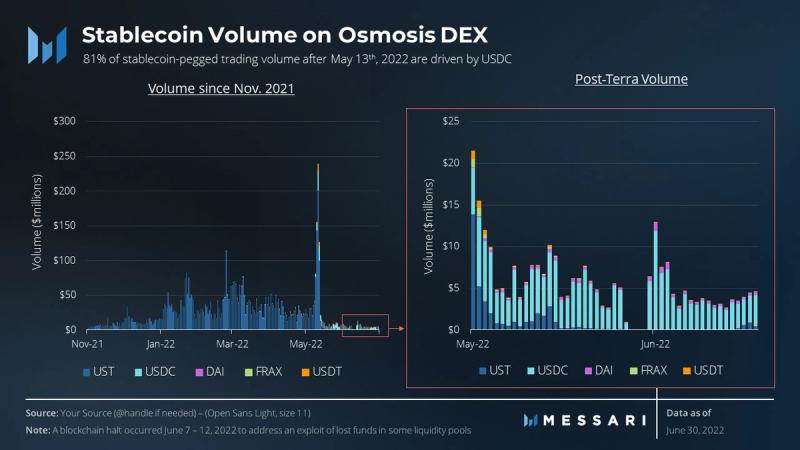
Actual trading data of stablecoin pools shouldn’t surprise anyone. Prior to the middle of May, volumes were almost exclusively facilitated by UST. It wasn’t until May 11 when a majority of stablecoin volume shifted from UST to USDC and/or DAI. By the end of June, less than 5% of stablecoin trading was through UST — generously calling it a “stablecoin” by that time. On June 16th, Osmosis announced both UST and LUNA were removed from the protocol’s main front-end platform and moved to its “frontier”, i.e. experimental, platform.

The stablecoin expansion still has a long way to go. What remains of UST at quarter end is $430,000 of liquidity, down $70,000 from a month prior and from an all-time-high of $280 million on April 2. Clearly a significant chunk of capital fled the Osmosis ecosystem in the last several months by way of price depreciation or LP pullback. Less than 5% of that has been replaced by a mix of USDC and DAI, which add up to less than $20 million in liquidity across all pools.
The disparity highlights how much of a hit Osmosis took once Terra fell. But optimistically, it reinforces how a future multichain paradigm could look. Take, for example, a look at the list of Terra applications that migrated over to Osmosis as the Terra ecosystem fell. Osmosis was the top contender for many of Terra’s biggest DeFi apps, such as Mars Protocol, Andromeda, Apollo Safe, and others. Bringing more applications or tokens to Osmosis, either through traditional two-asset or multi-asset pools appears to be what will catalyze future growth.
Qualitative Analysis
Governance Participation
In crypto, decentralized decision making requires active involvement. According to Flipside Crypto, it takes about 22 days on average for a wallet to engage with governance, and only 7% of wallets holding OSMO have never voted.

Deeper analysis of governance participation by number of wallets shows a left-skewed data set. Roughly half of all Osmosis wallets participated in 10% or less of submitted proposals. That’s equivalent to about 20 proposals. The other half is more active, ranging from 10% up to 100%. A very select number of wallets (134) achieved perfect attendance. Surprisingly, there was one specific participation rate that was an outlier: more than 7,750 wallets participated in 80% of all proposals, but go up or down a few percentage points and it falls back down to a few hundred. Those wallets likely belong to members of the internal team, active outside investors, or those delegating with a large bloc.
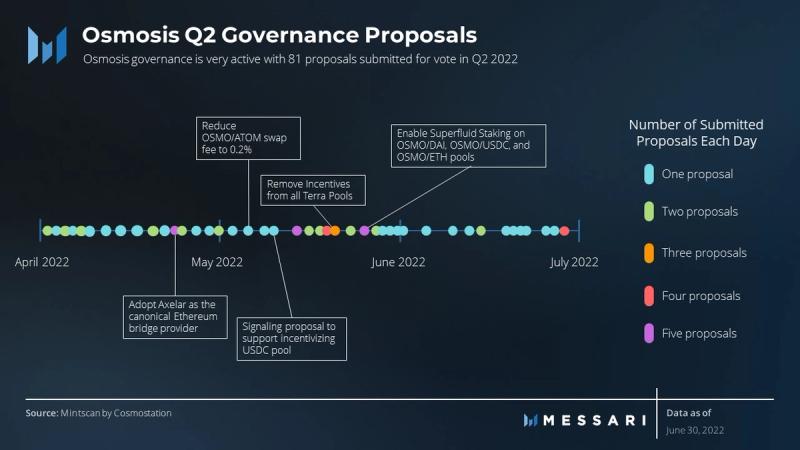
Select Governance Updates
There were 81 governance proposals submitted in Q2 alone. Several days had multiple proposals, including three separate times when five proposals were on the same day. The following are select Q2 proposals which helped drive the protocol forward:
April 22, 2022 – #206: Adopt Axelar as the Canonical Ethereum Bridge Provider
A community vote was held to determine which cross-chain bridge should be selected as the Ethereum bridge provider. In return, the DAO made a promise to create heavier incentive programs to encourage the bridging of tokens using the selected bridge. After a RFP process where Axelar, Gravity, Nomad, and Wormhole submitted bids, the community voted to make Axelar the bridge service provider for Osmosis. Note, however, the difference between ERC-20 and IBC-based stablecoins. The former is a wrapped asset that must be minted rather than a native asset of their chain.
May 3, 2022 – #214: Reduce OSMO/ATOM Swap Fee to 0.2%
At the time of vote, most OSMO-pools charged a 0.2% fee to facilitate trades. However, the largest pool, OSMO/ATOM, charged 0.3%. This was particularly egregious because Osmosis had just enabled multihop swapping. Multihop swapping allowed traders to make two non-OSMO trades from one asset to another with OSMO as the intermediary and only pay half the typical fee trade. As a result, traders could get the benefit of low slippage (as liquidity was concentrated in OSMO pools) and still pay a 0.2% fee. Bringing the OSMO/ATOM fee effectively enabled traders to trade from some third token to ATOM and still only pay 0.2% in fees for the trade.
May 8, 2022 – #218: Signaling Proposal to Support Incentivizing USDC Pool
Once a canonical bridge service provider was decided upon by governance, a vote was taken to gauge interest in incentivizing USDC tokens on Osmosis. Approval of such a decision meant two things. First, it would allow USDC to be added to Osmosis’s regular incentive program. More importantly, it would signal the Osmosis community’s welcoming of bridging over prevalent ERC-20 tokens such as stablecoins and ETH. The decision passed handily with 93.43% of voters voting Yes.
May 19, 2022 – #219: Remove Incentives from all Terra Pools
The LUNA ecosystem once made up over 50% of trading volume among the top four largest markets. Unfortunately, the depegging of UST led to extreme volatility of the asset, rendering it useless as the native stablecoin across Osmosis. The governance proposal to remove all incentives from Terra-based pools had a practical purpose: stop distributing rewards to something that was no longer vital to the health of the DEX. Beyond that, it also represented the symbolic end of LUNA’s status as an algorithmic stablecoin project.
May 26, 2022 – #235: Enable Superfluid Staking on OSMO/DAI, OSMO/USDC, and OSMO/ETH Pools
Superfluid staking is one of Osmosis’s core differentiators. It allows LPs to supply OSMO as liquidity for a market while the protocol simultaneously uses the same OSMO for validator staking and shared security. LPs hence double up their rewards via DEX fees as well as staking yields. Once ERC-20 tokens were bridged to Osmosis, three core pools saw superfluid staking enabled. The vote passed with over 99% of users voting Yes.
Closing Summary
Osmosis was not immune to crypto’s rough Q2. In fact, by nature of its proximity to Terra, Osmosis was closer to the center than most other protocols. Nonetheless, Osmosis survived and continues to adapt to changing environments. These accomplishments speak highly to the fundamental value proposition of the protocol: to become the core DEX for a multichain ecosystem. It is an ambitious but potentially necessary goal. Only time will tell how Osmosis performs after the industry’s recent setbacks.
Let us know what you loved about the report, what may be missing, or share any other feedback by filling out this short form.
This report was commissioned by Osmosis Labs, a member of Protocol Services. All content was produced independently by the author(s) and does not necessarily reflect the opinions of Messari, Inc. or the organization that requested the report. Paid membership in Protocol Services does not influence editorial decisions or content. Author(s) may hold cryptocurrencies named in this report.
Crypto projects can commission independent research through Protocol Services. For more details or to join the program, contact ps@messari.io.
This report is meant for informational purposes only. It is not meant to serve as investment advice. You should conduct your own research, and consult an independent financial, tax, or legal advisor before making any investment decisions. The past performance of any asset is not indicative of future results. Please see our terms of use for more information.



















